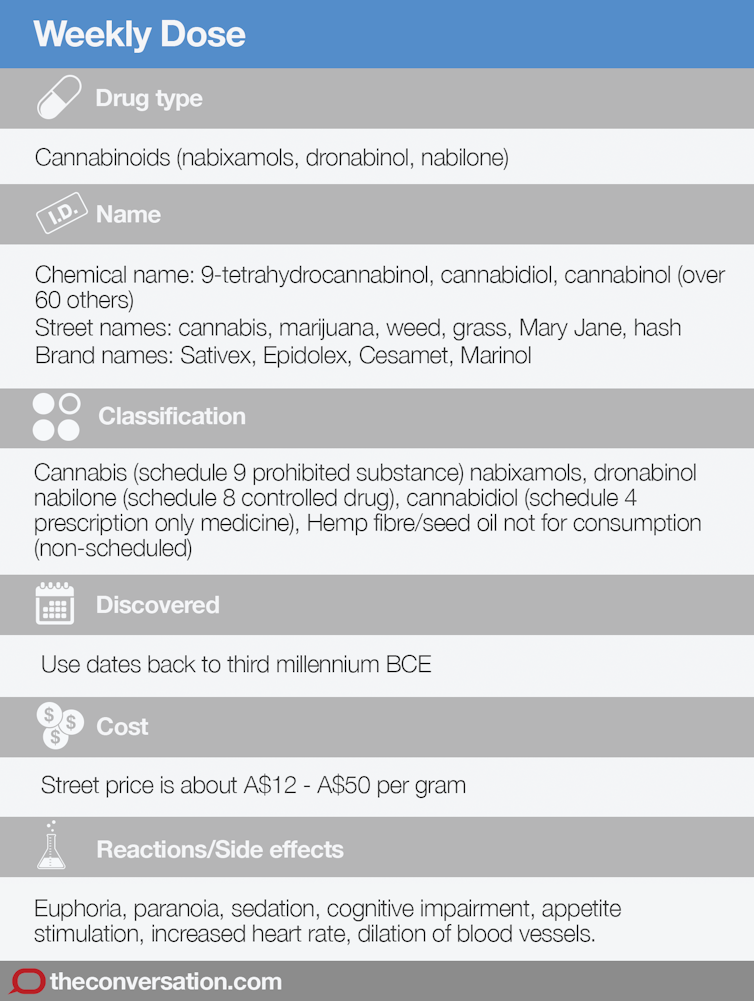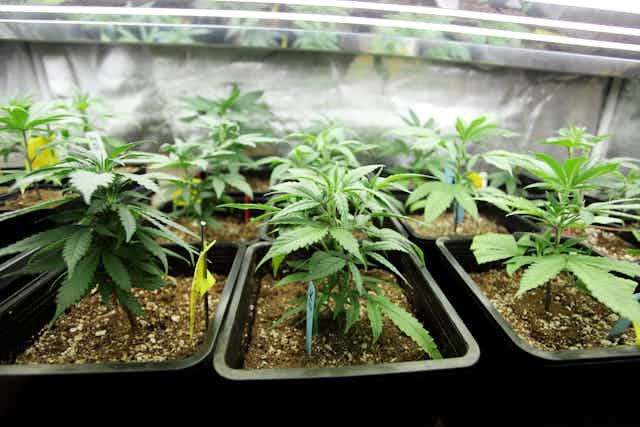Cannabis has a long history, and its misuse hangs over it like a dark shadow.
Cannabis is used recreationally for its euphoriant effects. But it also has the potential for effective therapeutic use. With mounting evidence for its medicinal benefits, there have been increasing calls for its decriminalisation and legalisation.

Some history
Used for centuries across various ancient cultures both medicinally and recreationally, cannabis has its roots in Central and South East Asia from as early as the third millennium BCE.
The use of cannabis for purposes of healing predates recorded history. The earliest written reference is found in the 15th century BC Chinese medicine list, the “Rh-Ya”.
Cannabis pollen was found on the mummy of Ramesses II, who died in 1213 BC. Prescriptions for cannabis in Ancient Egypt included treatment for the eyes (glaucoma), inflammation, as well as administering enemas.
In ancient Greece, cannabis was used as a remedy for earache, swelling, and inflammation. The history of mankind has a plethora of evidence for the use of medicinal cannabis dating back centuries.
It was used recreationally by the ancient Chinese and by Hindus of India in religious celebrations of the God Shiva. Around this era, the use of cannabis also expanded in ancient Egyptian ceremonies and swept throughout the Middle East as its psychoactive effects became popular.
Cannabis began to appear in conventional Western medicine in the 19th century, when its plant-derived formulations were believed to relieve pain, inflammation, spasms, and convulsions.
Today, evidence relating to medicinal benefits of cannabis in many patients is still more anecdotal than evidence-based, but there is mounting clinical evidence to support the claim that cannabis has significant beneficial effects on various conditions.
How it works
Marijuana or cannabis are general terms used interchangeably to describe preparations of the cannabis plant. Cannabinoids are the active constituents of cannabis, with at least 60 of these constituents believed to have some pharmacological activity. The main psychoactive component is 9-tetrahydrocannabinol (THC).
Other more promising components include the non-psychoactive, anti-anxiety agent and antispasmodic cannabidiol (CBD), as well as cannabinol (CBN), which has non-psychoactive, anti-inflammatory effects.
THC acts on the CB1 cannabinoid receptors in the central nervous system, and is known to cause sedation, amnesia and appetite stimulation. It affects memory, motivation and pleasure. CBN is known to act on CB2 cannabinoid receptors, which influence our immune system and inflammatory activity, while CBD’s mechanism of action is still not fully understood.
Relatively few studies have investigated the evidence behind the medicinal use of cannabis. In a recent review of the literature a total of 27 studies, all conducted after January 2000, were found. The reviewed articles explored cannabis use for the treatment of various symptoms, including pain, nausea and vomiting, anorexia, sleep, muscle spasm, urinary tract symptoms and inflammatory bowel disease symptoms. The majority of the studies found medicinal cannabis improved symptoms.
What it’s used for
Medicinal applications of cannabis include pain relief, treatment of multiple sclerosis, inflammatory bowel disease, cachexia (weakness from chronic illness), cancer-induced nausea and vomiting, Parkinson’s disease and potentially, sleep apnoea. Submissions for further investigation have been made and clinical trials are currently being undertaken to investigate the benefits of medicinal cannabis for epilepsy in both adults and children as well as terminal illnesses.
Recreationally, cannabis use or abuse is grounded on the psychoactive effects of the THC component, which cause euphoria, paranoia, sedation, cognitive impairment, and feelings of light-headedness, giddiness and relaxation.
Other more brief side effects include blurred vision, sedation, increased heart rate, and bloodshot eyes. Cannabis is also known to stimulate eating by activating sections of the brain that regulate food intake (the hypothalamus), and make food seem more palatable (the limbic system). It also instigates hunger from within the stomach and intestinal tissue.
Because of the relatively low number of cannabinoid receptors in the brain, overdosing on cannabis is virtually impossible and its potential to be addictive is based on the presence of THC. THC affects the reward centre of the brain, leading to a surge of dopamine – the pleasure chemical.
When using CBD or CBN extracts, these side effects on cognition and addiction are absent. Finding a standardised formulation that optimises the medicinal effect while minimising adverse effects is a difficult quest in the manufacturing and development of all medications.
Costs
The Australian Crime Commission estimates the street price of a gram of cannabis ranges between A$12 and A$50.
The projected costs in pharmacies are unclear, but based on pharmacoeconomics and calculations for currently registered products such as nabixamols (mouth sprays for treatment of spasticity in multiple sclerosis), it would cost A$15,000 to A$45,000 for a year of effective treatment.
If it was subsidised by the Pharmaceutical Benefits Scheme, the net cost per year is estimated to be A$10 million to $30 million, while the average cost to a patient is estimated to be around A$500 to A$800 a month.
These projections, however, are likely to be exaggerated, with current compassionate access schemes and clinical trials providing products with no charge. As awareness increases and legislative procedures made clearer, the pricing is also likely to drop.
Legalising cannabis
In Australia, the Therapeutic Goods Administration has approved the man-made Dronabinol (for the treatment of anorexia in HIV/AIDS and chemotherapy-induced nausea and vomiting), Nabilone (also for chemo-induced vomiting) and Nabixamols.
Countries including the United Kingdom, Denmark, Czech Republic, Austria, Sweden, Germany, and Spain, as well as 23 US states, have all formally approved the use of cannabis-based products, thereby decriminalising its therapeutic use. However, cannabinoids generally remain illegal everywhere else in the world.
Earlier this year, the Victorian government passed the Access to Medicinal Cannabis Bill 2015 as a plan to have medicinal cannabis available by 2017. Victoria, along with Queensland, joined NSW’s clinical trials into the cannabis-based drug Epidolex, with a focus on children with epilepsy, as well as a trial for the terminally ill taking place in Newcastle’s Calvary Master Hospital.
In February, the Australian Federal Parliament passed national legislation to allow the cultivation of cannabis in Australia for medical or scientific purposes, described by the health minister as:
paving the way for the use of medicinal cannabis by people with painful and chronic illness.
As of July 2016 the Therapeutic Goods Administration rescheduled cannabis from a prohibited substance (schedule nine) to a controlled drug (schedule eight), and cannabidiol became a prescribed substance (schedule four).
The greatest change occurred almost overnight in New South Wales, when The Poisons and Therapeutic Goods Amendment Regulation 2016 was implemented on August 1, 2016, allowing NSW doctors to apply for an authority to prescribe unregistered cannabis-based products for patients with unmanageable conditions who have exhausted all commercially available treatments.
Cautious progress has been made in making medicinal cannabis available and accessible in Australia; however, it is still a confusing tangle of state and federal legislation.
Pharmacy honours graduate Sami Isaac also contributed to this article.
* The graphic has been updated since publication to better relfect the classification of cannabidiol.

